The best diners are the dirtiest.
Determining the authenticity of a diner proves difficult in a town like Cooperstown; a proliferation of tourist traps confuse the eye and bewilder the tongue; main street, three ice cream parlors, a wax museum of baseball legends, the hall of fame: everything dances wildly between the bases of reality. Nevertheless, somewhere between the Triple Play Café and a hidden ballpark hot dog joint the Cooperstown Diner takes a daring leap. No gimmicks, no cheap tricks, no sideshow thrills. This diner is “dirty”—the tablecloths feel waxy and get a quick wipedown after each guest (a hint of stickiness remains), and dinge crowds the walls with a veneer of shabbiness. A fly buzzes idly and then nosedives into a recently poured cup of coffee, drowning. The Cooperstown Diner feels dirty without the actual grime, age and wear accumulating a palpable presence. It is deliciously authentic.
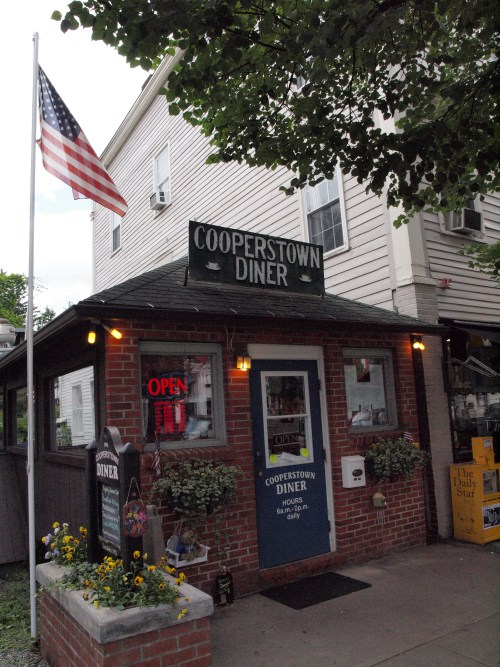
For breakfast, locals and visitors squeeze into the boxy interior, a
homey space crammed with tables, a stocky counter, and too many
half-amusing signs to read. The kitchen slowly sends out plates, since
the diner occupies a unique time zone that demands lingering over
bracing coffee before the meal begins. As an analog clock drips a steady
rhythm alongside the muffled clatter of forks and knives, the diner
swings about a steady axis: two brunettes work the room with a brusque
efficiency that contradicts the kitchen’s determined march to lunch.
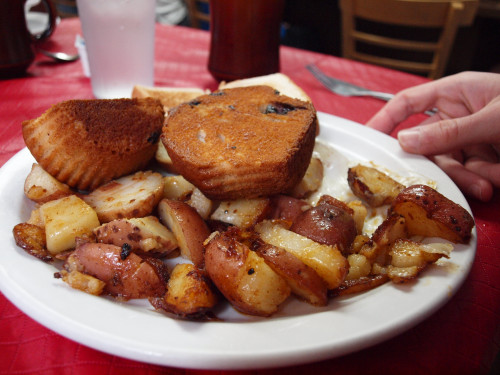 A
grilled blueberry muffin arrives atop over easy eggs and homefries.
With a crunchy surface and steaming interior, the muffin mops up yolk
and salt and provides a welcome interlude from bites of slightly
undercooked potato.
A
grilled blueberry muffin arrives atop over easy eggs and homefries.
With a crunchy surface and steaming interior, the muffin mops up yolk
and salt and provides a welcome interlude from bites of slightly
undercooked potato.
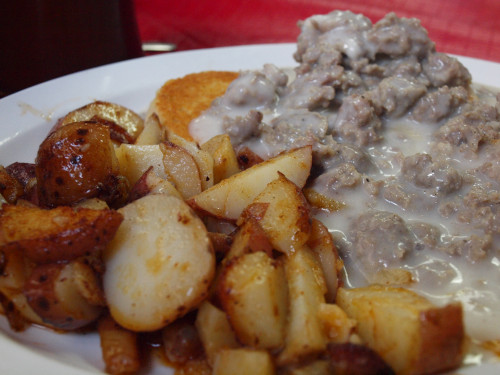 Sausage, gravy, and biscuits comes sloppy and wet, runnier than expected and studded with morsels of meat.
Sausage, gravy, and biscuits comes sloppy and wet, runnier than expected and studded with morsels of meat.
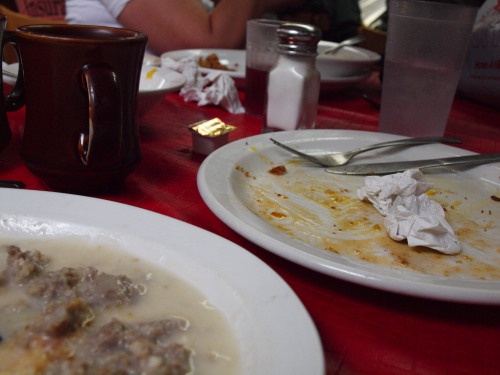 Soon,
plates are clean, a modest check settled, and our seats empty for a new
set of patrons. Each summer, Cooperstown awakens and rumbles to life
for the season, playing host to baseball celebrities and throngs of
banal tourists licking Italian ices and wandering dumbstruck from gift
shop to gift shop. I love it. And I love this diner, a barely noticed
spot that shows a sleepy town’s dirty side.
Soon,
plates are clean, a modest check settled, and our seats empty for a new
set of patrons. Each summer, Cooperstown awakens and rumbles to life
for the season, playing host to baseball celebrities and throngs of
banal tourists licking Italian ices and wandering dumbstruck from gift
shop to gift shop. I love it. And I love this diner, a barely noticed
spot that shows a sleepy town’s dirty side.
***
Buffalo snores in a different variety of somnolence, an industrial, narcotic dizziness that leaves entire blocks burnt out and devoid of life. Sagging and tired, streets rest empty and cold, abandoned lots yielding to fast food chains and abandoned projects. Just beyond the city’s rougher patches where gangs relax on collapsing porches and each corner feels wearily threatened, an unexpected candy shop springs from the crushed pavement.
Parkside Candy flickers gaily amongst a faded urbanscape, a neighborhood institution since 1927. Like St. Louis, Buffalo’s center of wealth seems to have shifted in the intervening decades, leaving this lonely shop to hawk “Fresh Strawberry Sundaes” to the occasional passerby. Even Parkside’s once brilliant colors appear washed out now against an overwhelming expanse of brick and concrete; the building wheezes with emphysema, a tarry mass of memory that dirties the air. Here, there is loss, an evaporation of childhoods no longer remembered, the inexorable progress of time that leaves a fine sediment of history. The effect is Pompeian, spaces left where ebullient children clutched for ice creams and parents too smiled mysteriously of inward happiness.
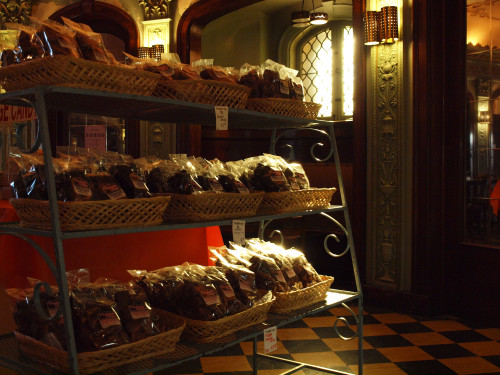 Sponge
candy is the speciality; chocolate-covered squares of honeycombed
caramel sweetness that dissolve on the tongue. The taste disappears, a
ghost of desire, a fleeting breath of childness. I imagine that
Nabokov’s Lolita enjoyed this treat with Humbert Humbert at her side.
Watching with disapproval and carnal longing, Humbert would wait
impatiently. On their trip across America, what candy shops he must have
suffered. Thus, sponge candy feels Lolita-esque, a nymphet that
represents time lost, childhood regained.
Sponge
candy is the speciality; chocolate-covered squares of honeycombed
caramel sweetness that dissolve on the tongue. The taste disappears, a
ghost of desire, a fleeting breath of childness. I imagine that
Nabokov’s Lolita enjoyed this treat with Humbert Humbert at her side.
Watching with disapproval and carnal longing, Humbert would wait
impatiently. On their trip across America, what candy shops he must have
suffered. Thus, sponge candy feels Lolita-esque, a nymphet that
represents time lost, childhood regained.
Getting dirty during dinner also awakens the inner child, and this cathartic exercise occurs most frequently at bars and BBQ restaurants, playgrounds for adults. At The Anchor Bar, buffalo wings are the only sensible dinner option. In 1964, the chicken wing was supposedly “invented” at this roadside behemoth that straddles tough neighborhoods and bustling downtown. Currently, Korean fried chicken holds New York enthralled with super crispy skin and tongue numbing hot sauce. Maybe I’m a sucker, but the wings at The Anchor Bar are the best I’ve ever eaten. Pork rind crunchy skin covered in vaporous, volatile orange sauce sheaths ample caches of juicy meat.
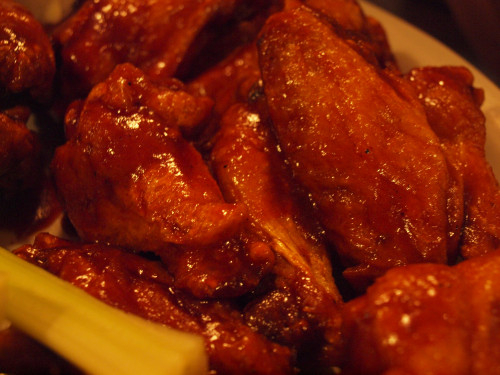 Hands
got dirty. Pants got dirty. Face, hair, under the fingernails, these
wings invited full body eating. Still, finished with another clean
plate.
Hands
got dirty. Pants got dirty. Face, hair, under the fingernails, these
wings invited full body eating. Still, finished with another clean
plate.
Dining is about digging deep, whether on a social, psychological, or physical level. Eating on the dirty side is the only way to eat.

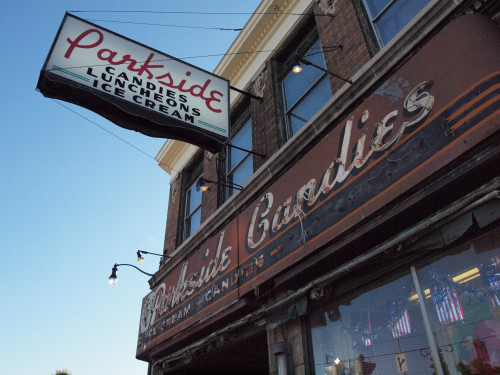
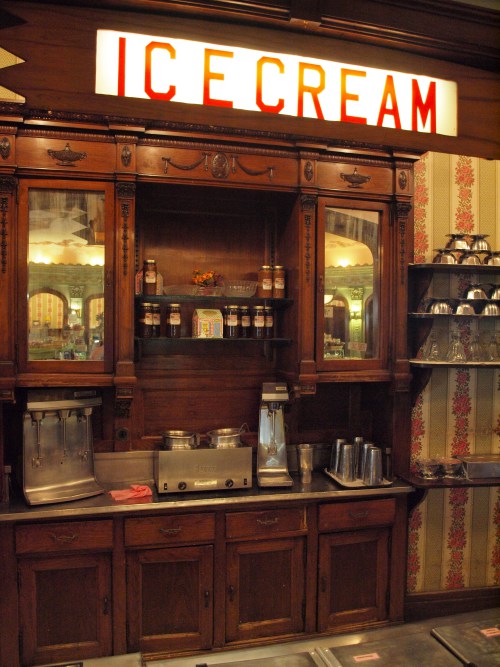
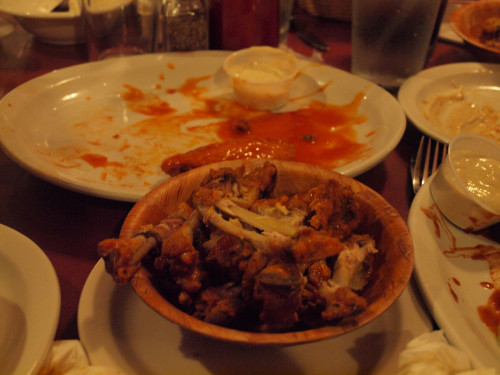
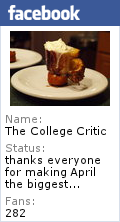
jason likes it dirty
I like it dirty too. Too clean is just sterile!
I like the idea of grilling the muffin!